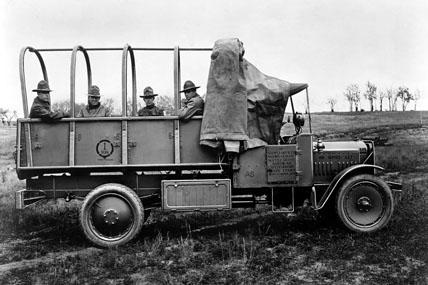The U.S. Army's first use of trucks in a military operation was in the "Punitive Expedition" in pursuit of "Pancho" Villa into the mountains of northern Mexico in 1916. The Villistas had raided Columbus, N.M., killing several people and causing much damage. Brig. Gen. John Pershing organized a large force of troops, horses and vehicles to catch Villa. Among the motor vehicles were some 1915 GMC Model 15, three-quarter-ton trucks.
The operation encountered very severe conditions while going 400 miles into the Mexican state of Chihuahua, mostly over very rough terrain. Many of the trucks were stuck in the sand or mud and abandoned.
Although they did not catch Villa, the Army learned much about motor vehicle operation and support requirements and consequently was better prepared to use mechanized vehicles when it became involved in World War I in 1917.
The first large-scale use of motor vehicles in warfare occurred during "The Great War," starting in 1916. Early on, the British used a number of GMC Model 15 trucks, similar to those used in pursuit of Pancho Villa. GMC developed the improved Model 16 three-quarter-ton truck and released it in 1916.
When the U.S. entered World War I, new impetus was given to the Model 16 for military use, and it became the Class AA military truck for the duration of World War I. Of the 13,316 Model 16 trucks produced, the major portion built in 1917 and 1918 were for military use.
The U.S. Army developed a classification of military vehicles and chose preferred supplies for class. GMC was selected to be the primary source for Class AA three-quarter-ton trucks. The military version was designated as GMC mode 16AA. The most common application was for field ambulance service.
The company's booklet titled "GMC Ambulances" reads: "It is to the credit of the United States government that in every phase of preparation for the great war, the utmost consideration was given to providing comfort for the soldiers; not only during the preparation term at the various encampments around the country, but in providing for their welfare on the field of battle.
"It is a source of much satisfaction to the General Motors Truck Company that the medical department of the United States Army found the GMC 3/4-ton chassis to meet the requirements of this very exacting service."
The Model 16 had a 132-inch wheelbase with 35-by-5 pneumatic ties. The 30 horsepower engine gave the truck a max speed of 25 mph.
Although most of the ambulances were assembled by GMC, demand soon exceeded the production capacity of GM's Pontiac division facility, so kits were devised that included all of the parts required to build an ambulance. Some of those kits were assembled by subcontractors in the U.S., such as Hupmobile, and others were built by American troops in France.
Other GMC trucks were used during World War I, including more than 2,400 Model 23, one-ton trucks used by the Signal Corps as light aviation tenders to support airplanes used for field reconnaissance. Some Model 23s carried troops and others supported artillery operations.
By the time the armistice was declared on Nov. 11, 1918, nearly 90% of GMC's truck production had been dedicated to building a total of 8,512 military vehicles.















